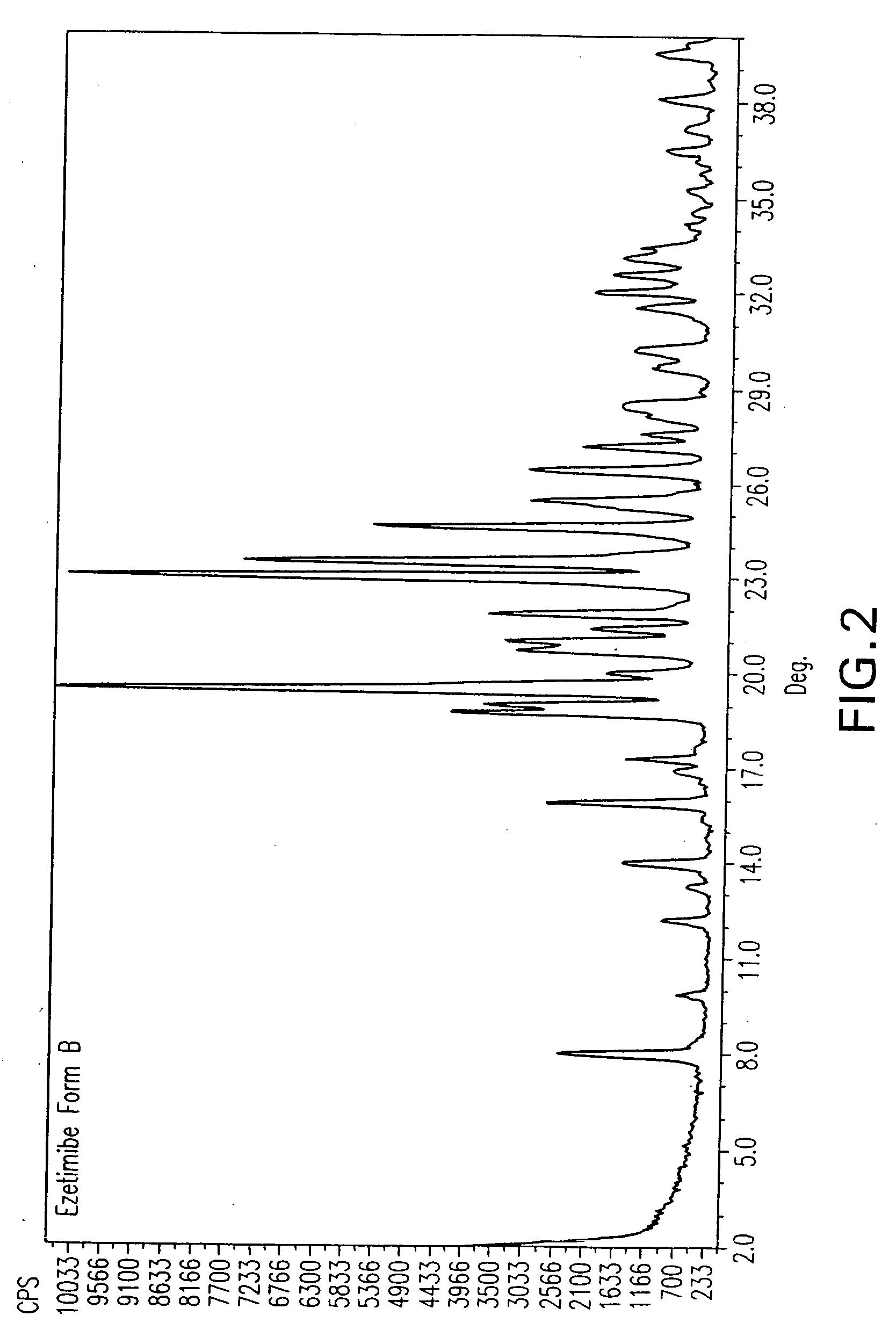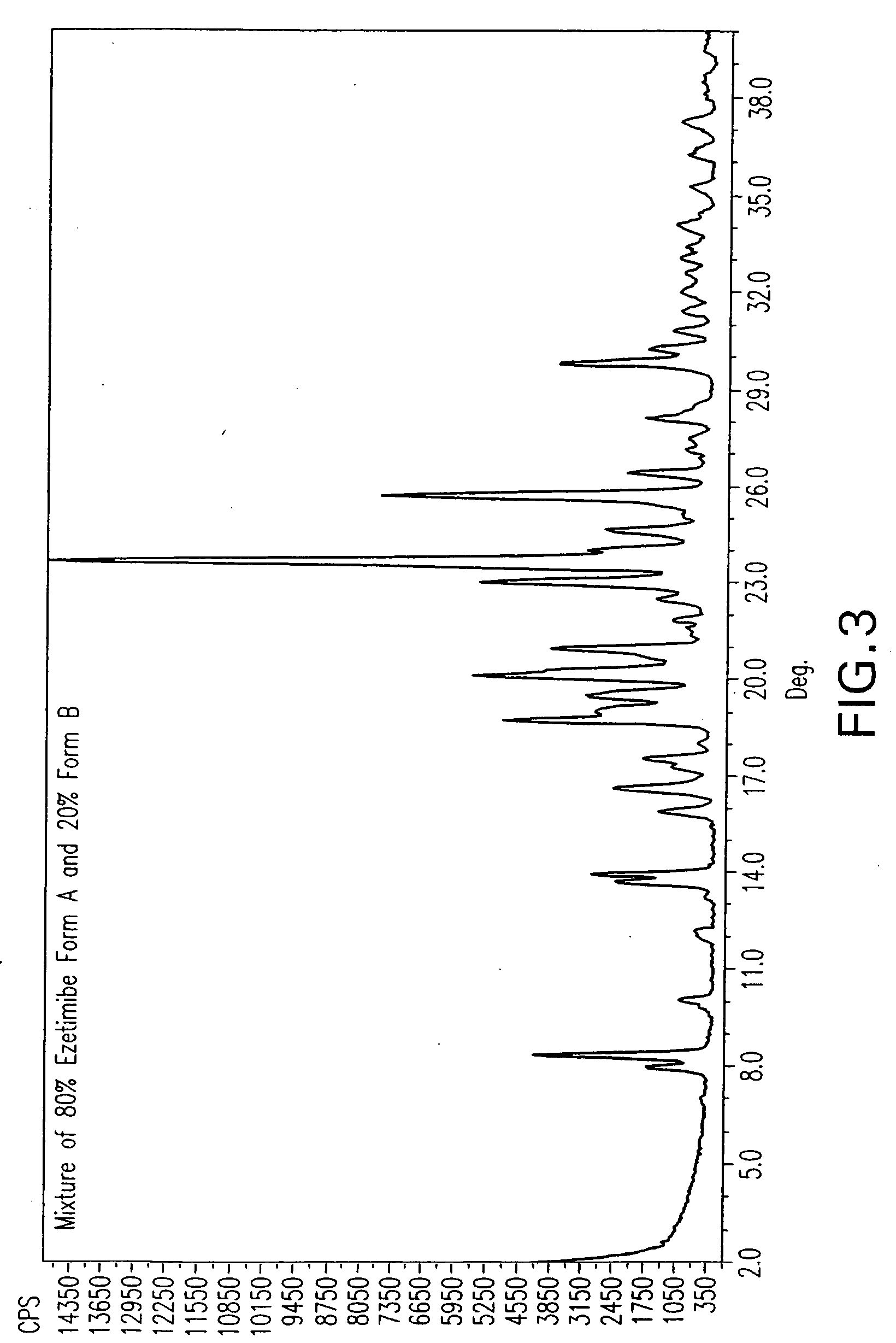Ezetimibe polymorphs
a technology of ezetimibe and polymorphism, which is applied in the field of micronized crystalline forms of ezetimibe, can solve the problems of reducing the delivery of intestinal cholesterol to the liver, and achieve the effect of reducing the delivery of intestinal cholesterol
- Summary
- Abstract
- Description
- Claims
- Application Information
AI Technical Summary
Benefits of technology
Problems solved by technology
Method used
Image
Examples
example 1
Particle Size Measurement of Ezetimibe Form A
Malvern, PSD, results of prime particles with sonication were as follows:
d(0.1): 0.39 microns, d (0.5): 3.18-3.33 microns, d (0.9): 7.95-8.05 microns.
example 2
Preparation of Ezetimibe Forms by Single Solvent Crystallization
[0160] 4 g of ezetimibe was dissolved in a solvent. The choice and volume of the solvent is shown in Table 3.
[0161] The mixture was stirred and heated to reflux. The reflux temperature is shown in Table 1. The solution was cooled under stirring to room temperature and then left at 4° C. for 16 h. The resulting precipitate was filtered using a Buchner funnel and sucked dry for 30 min on the funnel. The resulting sample, the “wet sample,” was studied by XRD. The wet sample was then dried under reduced pressure for 16 h. The dry sample was studied by XRD. The crystalline forms obtained from the wet and dry samples are shown in Table 3.
TABLE 3TempVol.Solvent(° C.)(ml)Dry ResultWet Resultmethyl isobutyl116.510Form AForm Bketonen-butanol11814Form AForms A + Bn-propanol9714Form AForm A + ˜20% B*Butyl Acetate124-12614Form AForm A + Bisoamyl alcohol13010Form AForm A + 8.3 +8.8 + 9.2 + 12.1 +24.6 + 26.5Bromobenzene15610Form A...
example 3
Preparation of Ezetimibe Forms by Solvent-Anti-Solvent Crystallization
[0162] 4 g ezetimibe was dissolved under stirring in a solvent at reflux conditions. The choice and volume of solvent and the reaction temperature for each experiment is shown in Table 4. An anti-solvent was added until precipitation began. The suspension obtained was cooled under stirring to room temperature and then left overnight at 4° C.
[0163] The resulting precipitate was filtered using a funnel and filter paper and dried for 30 min on the funnel / paper. The resulting sample, the “wet sample,” was studied by XRD.
[0164] The wet sample was dried under reduced pressure at 70° C. for 16 h and studied by XRD. The crystalline forms obtained from the wet and dry samples are shown in Table 4.
TABLE 4Anti-SolventSolventb.p.Vol.Anti-VolumeTempSolvent(° C.)(ml)Solvent(ml)(° C.)Dry ResultWet ResultTHF6610 mlwater20 mlrefluxForm AForm BEther34.6250 ml water50 mlRTForm AForm Bt-Butyl-5370 mlwater40 mlRTForm AForm Bmethy...
PUM
| Property | Measurement | Unit |
|---|---|---|
| Temperature | aaaaa | aaaaa |
| Temperature | aaaaa | aaaaa |
| Temperature | aaaaa | aaaaa |
Abstract
Description
Claims
Application Information
 Login to View More
Login to View More - R&D
- Intellectual Property
- Life Sciences
- Materials
- Tech Scout
- Unparalleled Data Quality
- Higher Quality Content
- 60% Fewer Hallucinations
Browse by: Latest US Patents, China's latest patents, Technical Efficacy Thesaurus, Application Domain, Technology Topic, Popular Technical Reports.
© 2025 PatSnap. All rights reserved.Legal|Privacy policy|Modern Slavery Act Transparency Statement|Sitemap|About US| Contact US: help@patsnap.com



